8 weeks without a supermarket – no problem at all!
Cruising often means longer passages or being out in the islands where there is nothing but coconut palms, at least no markets or supermarkets.
In times of Corona though even some people on land have to be able to cope without a regular visit of the supermarket.
On SHE SAN until today we always had fresh vegetables and fresh eggs, even during our 17 days Atlantic crossing, 37 days Pacific crossing, 90 days in Fiji’s Lau group, 40 days in the outer atolls of the Marshalls and 40 days in the far away islands of Micronesia.

Do you want to know how I do that?
Here I share with you my tips and tricks, how I store fresh produce to keep as long as possible:
Carots, cucumbers, salad, capsicon, brokkoli, grean beans, cabbage, eggplant in the fridge
Carots, cucumbers, salad, brokkoli and green beans I immediately store in boxes (or plastic bags) in which I put paper towels all around. The paper towels take up the humidity, so the vegetables stay drier themselves.

Cabbage and eggplant and other less sensitive vegetables I also store in the fridge as soon as there is space.
Every few days, just take out the wet paper, dry everything that is wet and repeat to fill in with a fresh dry paper towels.

In my experience vegetables can last (depending on the freshness in the beginning):
- Salad and mushrooms – maximum 1 week
- Capsicum, brokkoli, cucumbers, green beans, eggplant – maximum 2 to 3 weeks
- White and red cabbage (always take off the leaves from the outside one after the other and never cut open!) can last until up to 8 weeks
- Carrots (when the end and tips start to rot just cut them off) are in my experience the best and last 8 weeks and even longer!!
When I see that I have bought more than what we can consume I make some pickles with the vegetables as long as they are still in a good condition, though! (Tips on how to make easy pickles coming later ,-)

TIP: instead of the boxes there are also special plastic bags from TOPPITS which are designed for keeping fruit and vegetables for a longer time fresh in the fridge
Tomatoes, garlic and onions, potatoes and pumpkin outside the fridge
Tomatoes, garlic and onions, potatoes and pumpkin should all be kept dry and well areated and if possible without or little sunlight.
- Tomatoes I buy as green as possible and keep them in the kitchen (out of the sun) to be checked daily which ones get a mark or the first signs of wrinkling.
- Onions I hang into the net in the cockpit, not exactely dark, but well areated and they mostly keep several weeks.
- Garlic I keep on a kitchen towel in a flat bowl
- Potatoes I keep in a dark place next to the fridge in a place with a bit lesser temperature than the rest
- Pumpkin I keep in a dark place on the floor in one of the cabins – depending on how fresh it is it keeps several months without cooling
And before everything fresh is finished I make my own sprouts (for me mung been sprouts work best) which are excellent as salad or in stir fry or to freshen up a can of vegetables 😉
Keep fresh fruit up to 4 weeks
Here in the tropics my rule is: buy the fruit as “green as possible”, it will become ripe anyway too fast.
I keep papaya, pineapple, mango and passion fruit, lemon and lime all in a big net outside in the cockpit. There it is well areated and protected from most of the sun. Cooler would be better, but my experiance is that most of the fruit (incuding tomatoes and avocado) emit ethylen, a substance that enhances the ripening process. Therefore I prefer to keep them well areaated instead of dark – after my stressful experiance before the Pacific crossing.
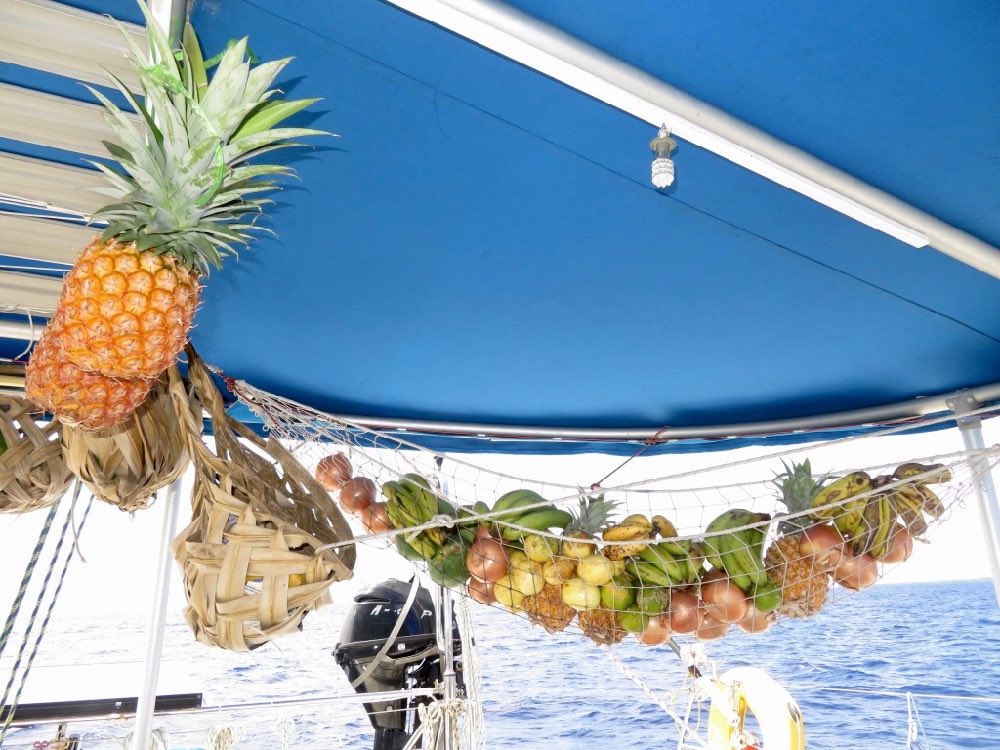
I check daily which fruit are becoming ripe and store these in the fridge
In case too many bananas ripen at the same time:
- amount for 2-3 days I put in the fridge as a whole
- larger quantities I cut into pieces and freeze (they become a bit brown, but that’s not a problem for into the morning oatmeal
- slice them and dry them on a metal baking sheet in the sun or
- cook them with 50 % sugar into glasses (great for banana bread/cake)
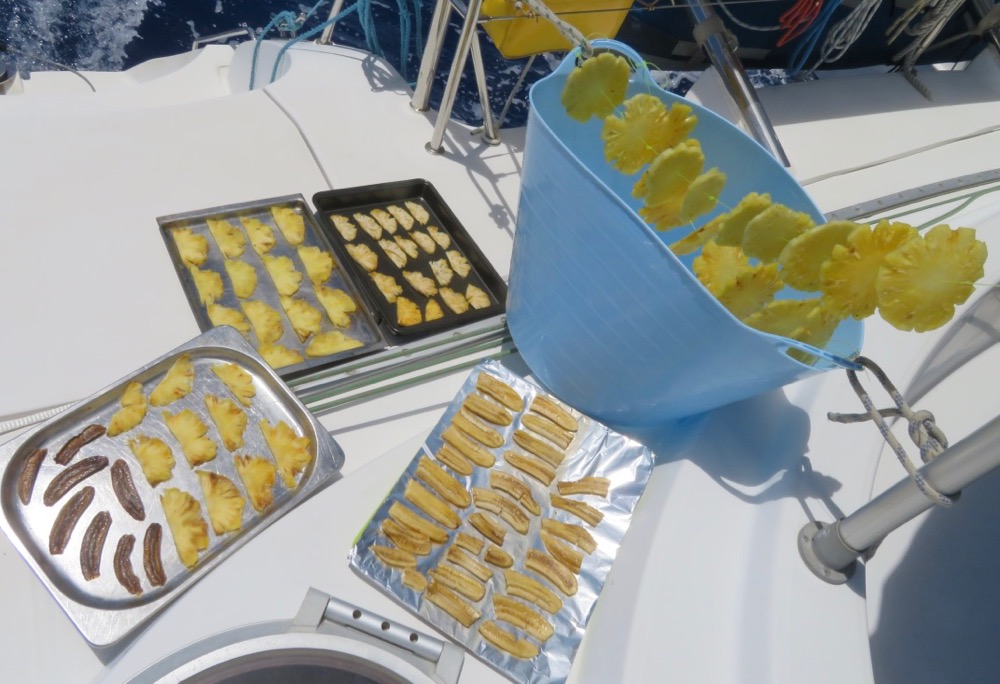
Storing eggs outside the fridge
In the beginning I always turned around the egg cartons once per day. This prevents that the egg yolk sticks to the shell and starts to rot.
This works but sometimes only limited I had to find out in the middle of the Pacific the hard way.
As soon as an egg has a small defect on the shell microbacteria (and oxygen) get in and the egg starts to rot.
So here the a bit more labor-intensive but absolutely invaluable tip from Karen from SV Katie G:
I dip every egg for 1 to 2 seconds into boiling water which creates a film of denaturated (cooked) egg white on the inside of the shell which prevents that the egg yolk can stick to the shell and in addition serves as a kind of a protection layer in addition to the shell
BIGGEST additional value of the process of dipping into hot water: I FIND EVERY egg that has a crack as fine as it may be, because I can watch the bubbles coming out from fine holes and also the egg white when there is a bigger crack. All these which have a crack you have to either eat quickly or put in the fridge.
All the “good” eggs I dry with a paper towel and put them into my own reused egg cartons, which I store next to the fridge in a place with around 25 degrees Celcius has a bit lesser temperature than the rest. In addition just to make sure I turn the cartons around every 3 days.
With this method I have kept already 8 weeks old eggs (kept in the fridge in the supermarket in the Marshalls) for another 8 weeks outside of the fridge and have not thrown away a single one!
Attention: nevertheless I still open every egg into a seperate bowl and inspect it. The smell has to be normal and it shouldn’t have any dark orange or brown spots in the egg yolk otherwise I throw it over board!
Another additional value of that procedure: in case there are eggs of cockroaches on the eggs they get at least already one hot bath and get wiped well. Also through away the egg cartons as soon as possible – I have more than once seen that cockroaches love them and they obvioulsly like to put their eggs in the cartons too…
Other tips for the galley on board:
Storage of dry goods
I never had any bugs or beetles or other animals in rice, flour and other dry goods but I store since the beginning everything in 5 l drinking water bottles.
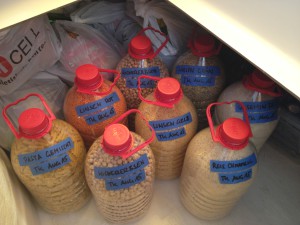
I do the same with pasta, but they are a bit hard to get out again 🙁 so today I prefer to put them into a ziplock bag.
Everything sensitive to humidity I seal into vacuum bags with a vacuum sealer: Chocolate with nuts (in order to prevent loss of crunchyness), loose goods like tea or pumpkin seeds (in order to prevent mold) and yeast for baking and brewing my fruit beer (to keep it fresh in the fridge)
Frozen food
If you have a freezer I recommend to also use a vacuum sealer to get a better quality of frozen meet and fish.
General rule: first eat what needs to be eaten!
I often make the mistake to ask Reto “What do you want to eat, spaghetti or lentils with vegetables?”. In the meantime he knows me too well and asks back “What needs to be eaten first?” and mostly it will be the vegetables…
The real art is to judge your supplies and understand what has to be eaten first, so that nothing else rots away in the meantime.
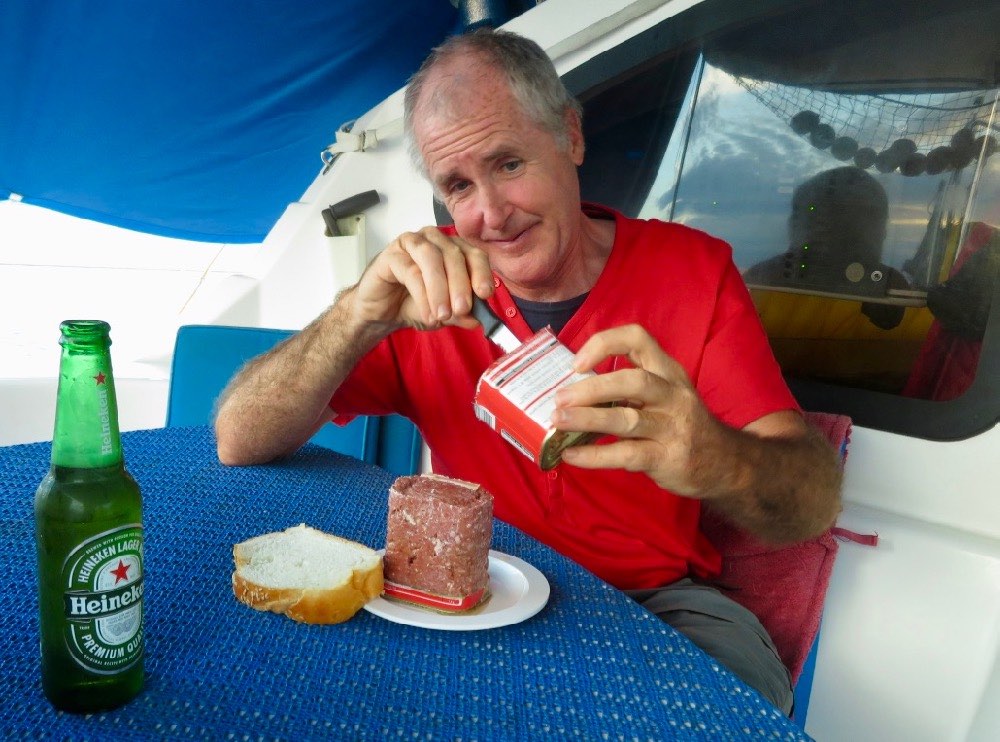
That’s the reason why my poor skipper only rarely gets to eat spaghetti with tomato sauce or delicacies such as tinned corned beef…
Did you like my post? Do you have any additional recommendations or questions? I really apreciate your comments below!
Thank you! Angela
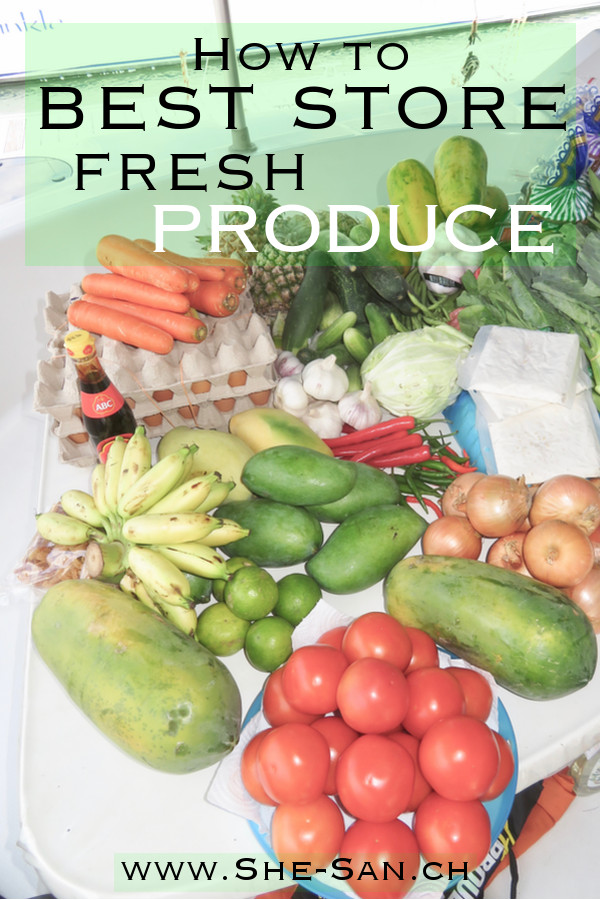

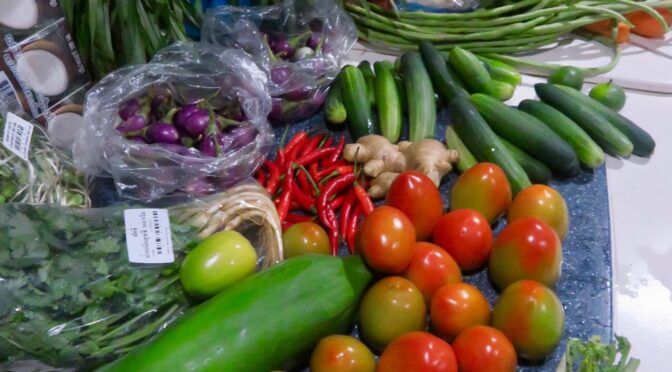

Fantastic Angela!! Precious tips!!
I’m always following your and Reto’s adventures. Would love to see you again and spend some time on a boat with you!
Hi Daniele, would be great to see you! Currently a bit difficult 🙁 Hope you are doing fine
When you say kitchen paper do you mean paper towels or parchment cooking paper?
Another tip. If you store onions and garlic in stockings or pantyhose with a knot tied loosely between each one so the skins can’t touch they will last indefinitely.
Dear Danny,
thank you so much for your comment. I wasn’t aware that I did a direct translation from German instead of looking for the correct English word ;-).
So what I mean is simple paper towels. When they are wet after 2 days, I take them out and let them dry to be reused for cleaning off dirt or similar usage.
Your tip with the stockings for onions and garlic sounds very interesting, I’ll try it out right away!
Thanks and take care!
Angela
Loving this post we are about to start our journey I’m now looking for hints and tips for storing food . Thank you
Dear Maria, good to hear that you profit from it. We just sailed up the Red Sea and were happy once again to be able to store fresh food for more than 4 weeks.
Best regards
Angela